
Along with NCERT Solutions For Class 7 Science Chapter 2 Nutrition In Animals, we also provide Notes and Lesson Plan made specially by our Study Rankers for better understanding. Students may read the NCERT Science Chapter 2 PDF to practice concepts with NCERT Solutions and Extra Questions prepared by keeping in mind the latest CBSE curriculum. Shine among your friends after scoring high in Quiz and Worksheet.
Read more: Ncert solutions for class 7 science chapter 8 Winds, Storms and Cyclones
Prologue
- Nutrition is defined as the process by which an organism obtains and utilizes the food necessary for its health and growth.
- This chapter enlightens us with the digestion processes followed by different organisms.
- The process of breakdown of complex compounds of food into simpler substances by digestive enzymes is called digestion.

- All organisms require food for growth repair and functioning of the body.
- Animal nutrition includes :-
- Nutrient requirement
- Mode of intake of food
- Utilisation of food in the body

Nutrition In Animals’ Quick Recap
Different Ways Of Taking Food
- The process of taking food into the body is called ingestion.
- The mode or way of ingestion varies in different organisms, for instance,
- bees and hummingbirds suck the nectar of plants,
- infants of human and other animals feed on mother’s milk,
- snakes swallow their prey,
- and aquatic animals filter food particles.
| Animal | Food | Mode Of Ingestion |
| Snail | Insects | Scraping |
| Ant | Grain | Scraping, Chewing |
| Eagle | Fish | Capturing, Swallowing |
| Bee | Nectar | Sucking |
| Lice | Blood | Sucking |
| Mosquito | Blood | Sucking |
| Butterfly | Nectar | Stiphoning |
| Housefly | Liq. Food | Sponging |
Did you know?
- Scraping is defined as the breaking of food by sharp teeth.
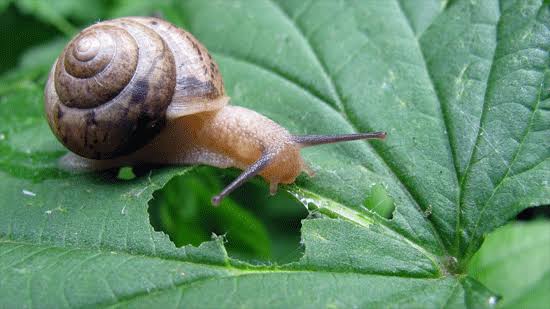
- Siphoning is defined as the transport of liquid food through a tube.

- The process of absorbing the food just like a sponge is called sponging.
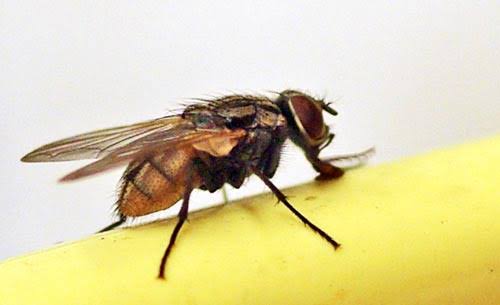
- Starfish feeds on animals with shells made of calcium carbonate. It pops out its stomach from its mouth to eat the soft animal inside the shell and then the stomach goes back to continue with the process of digestion.

Digestion in Humans
Digestive System
- After ingestion, food passes through a continuous canal, called alimentary canal or digestive tract, where gradual digestion of food takes place.
- This digestion is possible due to the secretion of digestive juices by various glands which breaks complex food substances into simpler forms.
- The alimentary canal begins at the buccal cavity and ends at the anus.
- The alimentary canal consists of:-
- Buccal cavity
- Oesophagus
- Stomach
- Small intestine
- Large intestine
- Anus

- The digestive tract with associated glands (salivary glands, liver, pancreas) constitutes the digestive system.
The Mouth and Buccal Cavity
Ingestion of food takes place through the mouth.
Teeth
- We chew the food and break it down into small pieces with our teeth.
- Each tooth is rooted in a separate socket.
| Type of Teeth | Function | No. of Teeth in Lower Jaw | No. of Teeth in Upper Jaw | Total No. of Teeth |
| Incisors | Cutting & Biting | 4 | 4 | 8 |
| Canines | Piercing & Tearing | 2 | 2 | 4 |
| Molars and Premolars | Chewing & Grinding | 6 and 4 | 6 and 4 | 20 |

| Milk Teeth | Permanent Teeth |
| First set of teeth | Second set of teeth |
| Grows during infancy | Replaces milk teeth after they fall off |
| Fall off at the age between 6 to 8 years | Last throughout the life or fall of at old age due to dental disease |
Salivary Glands
- The mouth has salivary glands that secrete saliva.
- The saliva breaks down starch (complex) into sugar (simple).
- Hence, boiled and chewed rice does not change it’s color to blue on the addition of iodine because the starch present in it is digested into sugar.
Tongue
- It’s a fleshy muscular organ attached at the back of the mouth, to the floor of the buccal cavity. It is free at the front and can move in all directions.
- Its functions include:-
- Aid in talking.
- Mixing saliva with food while chewing.
- Helps in swallowing.
- Helps in taste due to the presence of taste buds.
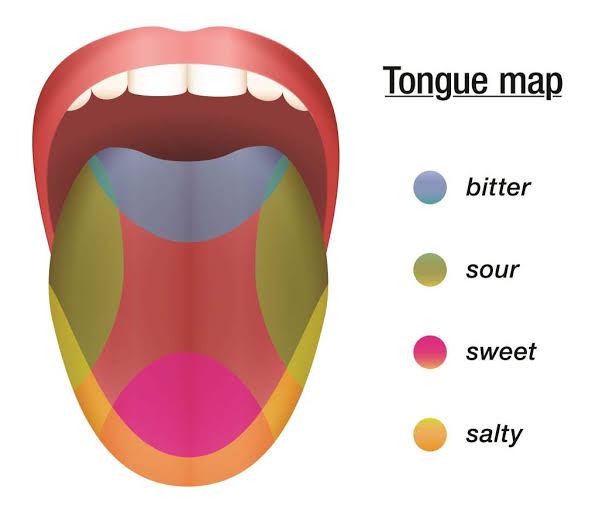
Sweets and Tooth Decay
- Chocolates, sweets, soft drink and others sugar products are major culprits of tooth decay.
- The bacteria present in our mouth breakdown the sugars from the leftover food to acids, which damage the teeth. This condition is known as tooth decay.
- Hence it is advised to brush your teeth twice a day and use dental floss.
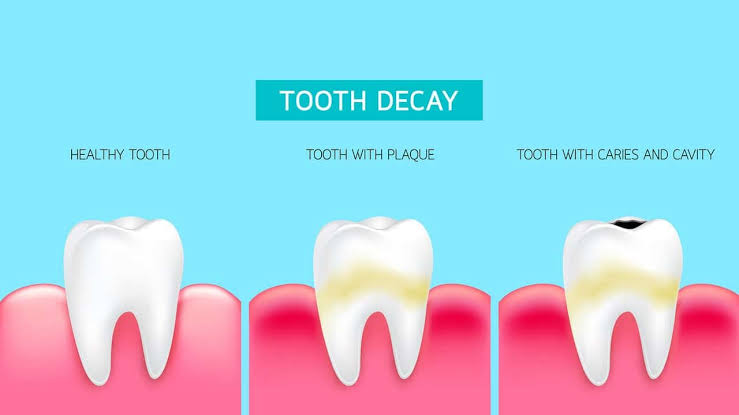
Here Are Some Precautions From Tooth Decay !
Windpipe and Foodpipe
- Windpipe carries air from nostrils to the lungs and runs adjacent to the food pipe.
- Inside the throat, food pipe and air pipe follow a common passage which can lead to entering of food in the windpipe and hence cause choking.
- But to avoid this, a flap-like valve is present at the top of the windpipe which closes the windpipe during swallowing of the food and hence prevents the entry of food into it.
The Foodpipe/ Oesophagus
- The swallowed food passes into the food pipe or oesophagus.
- It runs along the neck and chest.
- Food is moved down by the movement of the walls of the oesophagus (this movement takes place throughout the alimentary canal to push the food downwards).
- Food poisoning, ulcer, etc. , may cause the rejection of food into the stomach leading to vomiting.
The Stomach
- Working of stomach was first discovered by Alexis Saint Martin in 1822.

- The stomach is a thick-walled, flattened J-shaped bag. It’s the widest part of alimentary canal.
- It receives food from oesophagus and opens into the small intestine from the other end.
- The inner lining of the stomach secretes:-
- Mucous – which protects the inner lining of the stomach.
- Hydrochloric acid – which kills the bacteria and makes the medium in the stomach acidic, to help digestive juices indigestion.
- Digestive juices – breaks down proteins into simpler substances (amino acids).
Small Intestine
- It’s highly coiled and 7.5 metre in length.
- It receives secretions from liver, pancreas and it’s wall secretes intestinal juices.
| Gland | Appearance | Location | Secretion | Function |
| Liver | Reddish brown; largest gland in the body | Upper part of the abdomen to the right side | Bile juice stored in gall bladder (sac) | Bile helps in digestion of fats |
| Pancreas | Cream coloured; large | Just below the stomach | Pancreatic Juices | Digests carbohydrates, fats and proteins into simpler forms. |
| Walls of small intestine | Highly coiled | Lowest part of small intestine | Intestinal Juices | Completes the process of digestion |
| Complex Substance | Simpler Substance |
| Carbohydrate | Sugar/ Glucose |
| Fats | Fatty acids and glycerol |
| Proteins | Amino Acids |
Absorption in The Small Intestine
- Absorption is defined as the transportation of the digested food into blood vessels present in the walls of the intestine.
- The inner walls of the intestine posses a small finger-like outgrown called villi.
- Villi increase the surface area for absorption of the digested food.
- Each villus has a network of thin and small blood vessels close to its surface.
- The surface of the villi absorbs digested food material.
- Absorbed food material is transported to different parts of the body via blood vessels.
- Assimilation is defined as the process by which digested food is absorbed and transported to body organs to build complex substances.
- In cells, glucose is broken down into carbon dioxide and water with the help of oxygen to release energy.
- Undigested food is then pushed towards the large intestine.
Large Intestine
- It is wider and shorter than the small intestine. It is 1.5 meters in length.
- Its function involves the absorption of water and salts from the undigested food material.
- The remaining waste passes into the rectum and remains there as semi-solid feces.
- The removal of fecal matter through the anus is called egestion.
Diarrhoea
- The condition in which there is a need to pass watery stool frequently is called diarrhoea.
- It may occur due to infection, food poisoning, or indigestion.
- It can be fatal in some cases due to the excessive loss of water and salt from the body.
- Its first aid includes drinking plenty of boiled and cooled water with a pinch of salt and sugar dissolved in it. This solution is called an oral rehydration solution (ORS).
Digestion in Grass Eating Animals
- The grass is rich in cellulose (a type of carbohydrate). In ruminants, bacteria present in rumen helps in the digestion of cellulose. Humans and many animals cannot digest cellulose.
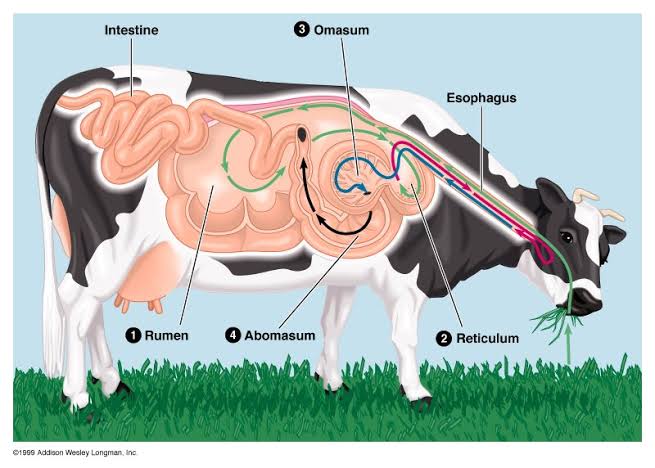
- These animals quickly swallow the grass and store it in a part of the stomach called the rumen.
- In the rumen, food gets partially digested and is called cud.
- Later, cud returns to the mouth in small lumps and the animal chews it.
- This process is known as rumination and the animals are called ruminants, for example – cattle, deer, etc.
- Animals like horses, rabbits, etc. , have a large sac-like structure called the caecum. It is present between the oesophagus and the small intestine. The cellulose is digested here.
Feeding and Digestion in Amoeba
- Amoeba is a single-celled, microscopic organism that is found in pond water.
- It has a cell membrane, rounded dense nucleus, and many bubble-like vacuoles in its cytoplasm.
- It constantly changes its shape and position.
- For ingestion, it pushes out a finger-like projection called pseudopodia (false feet). It also uses pseudopodia for movement.
- Amoeba feeds on microscopic organisms.
- On sensing food, it pushes out its pseudopodia and engulfs it.
- Food is trapped in the food vacuole.
- Digestive juices are secreted in the food vacuole to break down the food into simpler substances.
- Digested food is then absorbed.
- Absorbed substances play an important role in the growth, maintenance, and multiplication of amoeba.
- Residue food material is expelled.

NCERT Solutions For Class 7 Science Nutrition In Animals
Q.1.Fill in the blanks:
(a) The main steps of nutrition in humans are ___________, ___________, ___________ , ___________ and ___________
A) ingestion, digestion, absorption, assimilation, egestion.
(b) The largest gland in the human body is ___________.
A) Liver
(c) The stomach releases hydrochloric acid and ___________ juices which act on food.
A) digestive
(d) The inner wall of the small intestine has many finger-like outgrowths called ___________
A) villi
(e) Amoeba digests its food in the ___________ .
A) food vacuole
Q.2. Mark ‘T’ if the statement is true and ‘F’ if it is false:
(a) Digestion of starch starts in the stomach. (T/F)
A) False. It starts in the mouth.
(b) The tongue helps in mixing food with saliva. (T/F)
A) True.
(c) The gall bladder temporarily stores bile. (T/F)
A) True.
(d) The ruminants bring back swallowed grass into their mouth and chew it for sometime. (T/F)
A) True.
Q.3.Tick mark the correct answer in each of the following:
(a) Fat is completely digested in the
(i) stomach (ii) mouth (iii) small intestine (iv) large intestine
A) (iii) Small Intestine (by bile)
(b) Water from the undigested food is absorbed mainly in the:
(i) Stomach (ii) Food pipe (iii) Small intestine (iv) Large intestine
A) (iv) Large Intestine
Q.4.Match the items of column I with those given in column II:
| Column I | Column II |
| Food components | Product of digestion |
| Carbohydrates | Fatty acids and glycerol |
| Proteins | Sugar |
| Fats | Amino acids |
A)
| Column I | Column II |
| Food components | Product of digestion |
| Carbohydrates | Sugar |
| Proteins | Amino acids |
| Fats | Fatty acids and glycerol |
Q.5. What are villi? What is their location and function?
A) Inner walls of intestine posses small finger-like outgrowns called villi. Villi increase the surface area for absorption of the digested food.
Q.6. Where is the bile produced? Which component of the food does it help to digest?
A) Bile is produced in liver and stored in the gall bladder. It helps in the digestion of fats to glycerol and fatty acids.
Q.7. Name the type of carbohydrate that can be digested by ruminants but not by humans. Give the reason also.
A) Cellulose is digested by the bacteria present in the rumen of ruminants but humans can not digest cellulose due to the absence of enzyme cellulase.
Q.8. Why do we get instant energy from glucose?
A) Glucose is the simplest form of carbohydrate. It breaks down easily into carbon dioxide and water by oxygen and releases instant energy.
Q.9. Which part of the digestive canal is involved in:
(i) Absorption of food ________ .
A) Small Intestine
(ii) Chewing of food ________ .
A) Buccal Cavity
(iii) Killing of bacteria ________ .
A) Stomach
(iv) Complete digestion of food ________ .
A) Small Intestine
(v) Formation of faeces ________ .
A) Large Intestine
Q. 10. Write one similarity and one difference between the nutrition in amoeba and human beings.
A) Nutrition in amoeba and humans is similar because amoeba and human beings both require digestive juices to digest the food material. But, ingestion of food by humans is through mouth while egestion is through anus. Unlike in Amoeba, where, ingestion and egestion both are by pseudopodia.
Q.11. Match the items of Column I with suitable items in Column II.
Column I Column II
(a) Salivary gland (i) Bile juice secretion
(b) Stomach (ii) Storage of undigested food
(c) Liver (iii) Saliva secretion
(d) Rectum (iv) Acid release
(e) Small intestine (v) Digestion is completed
(f ) Large intestine (vi) Absorption of water
(vii) Release of faeces
A)
Column I Column II
(a) Salivary gland (iii) Saliva secretion
(b) Stomach (iv) Acid release
(c) Liver (i) Bile juice secretion
(d) Rectum (ii) Storage of undigested food
(e) Small intestine (v) Digestion is completed
(f) Large intestine (vi) Absorption of water
Q.12.Label Fig. 2.11 of the digestive system (as given in the NCERT Textbook Exercise)
A)

Q.13. Can we survive only on raw, leafy vegetables/grass? Discuss.
A) Human beings are directly or indirectly dependent on plants for their food. Plants are autotrophs and they can make their own food. Hence we can say that survival only on raw, leafy vegetables is possible to some extent.
FAQ’s Of NCERT Solutions For Class 7 Science Nutrition In Animals
Q. 1. Why ruminants cannot chew food properly at the time they take it in?
A) Ruminants eat grass which is rich in cellulose and hence difficult to digest. It is digested in rumen due to the presence of bacteria.
Q. 2. Why humans cannot digest cellulose?
A) Humans cannot digest cellulosebecause they lack the enzyme, cellulase, which helps in digestion of cellulose.
Q. 3. What will happen if humans consume cellulose?
A) Humans consume cellulose as fibres, which helps in movement of food in alimentary canal, but, in undigested form.
Q. 4. How does villi increase the surface area for absorption?
A) Villi are folded projections of small intestine and due to these folds, they increase the surface area for absorption as compared to a plain surface area.
Q. 5. What is the advantage of increased surface area for absorption due to villi?
A) The increased surface area of the inner lining of the small intestine allows easy absorption and active transportation of the food material.
Conclusion: NCERT Solutions For Class 7 Science Chapter 2 Nutrition In Animals
Above written includes NCERT Solutions For Class 7 Science Chapter 2 Nutrition In Animals, detailed Explanation, and Question Answers. Browse our site for various detailed and easy NCERT Solutions and CBSE Notes. Don’t forget to browse StudyEquation for more!